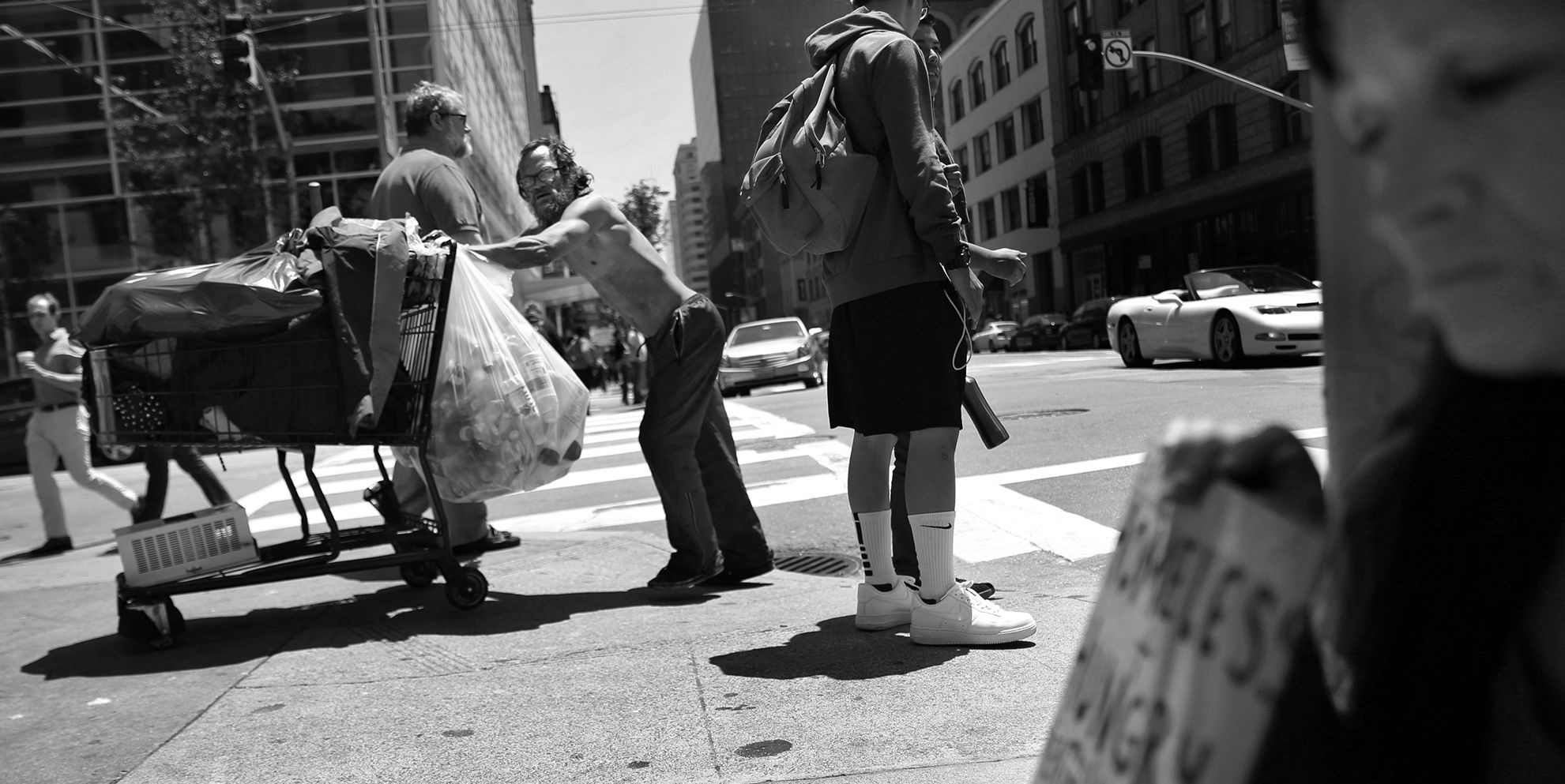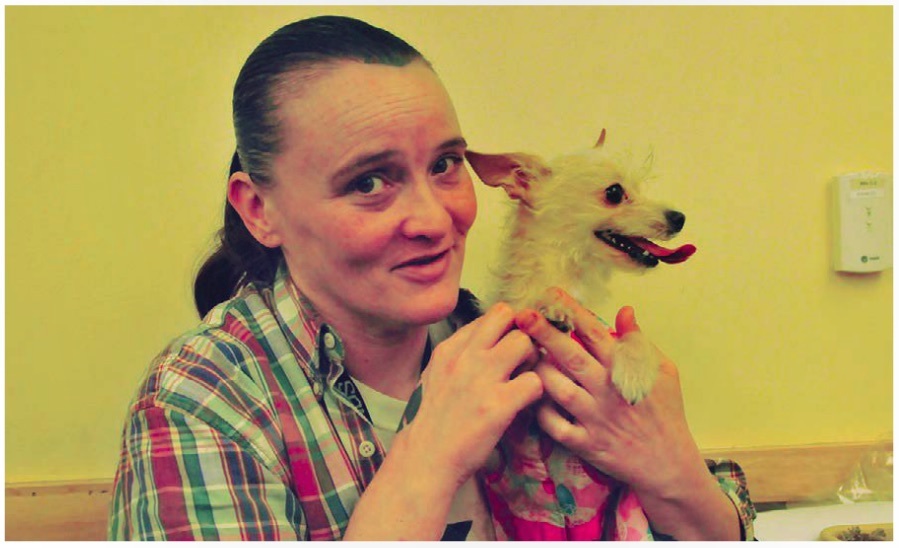[UPDATED: This story has been updated to reflect a correction in Chronicle Editor Audrey Cooper’s experience with homeless people having sex in a tent and her motivation for the homeless project.]
These are some of the headlines we saw in the San Francisco Chronicle this past year:
“San Francisco’s summer of urine and drug-addicted homeless.”
“Amid rising disgust, SF scrambles to flush stench from streets.”
“Flood of homeless in tent camp just small part of problem.”
“Mayor Lee’s Superbowl homeless plan is a breath of fresh air.”
There are others, less graphic:
“Myths, like the homeless problem, not going away.”
“Homeless problem can’t be swept away.”

There have been some very good stories (by reporters like Heather Knight) and some truly atrocious ones (by columnists C.W. Nevius and Deborah Saunders).
But overall, the Chron coverage of homeless people over the past year – until this week — has focused on problems way more than solutions, and is littered with words like “drugs,” “Drug-addicted,” “filth,” “feces,” and “crime.”
The papers editorials have consistently praised the mayor for his crackdowns – but have been alarmingly short on any positive suggestions, especially those that cost money or protect the rights of homeless people.
In 2012, when then-Assemblymember Tom Ammiano proposed a Bill of Rights for homeless people, the Chron mocked it as a “bad idea” and said it was “an absurd reaction to restrictions on homeless conduct and tough-love ideas such as San Francisco’s “Care Not Cash” program that substitutes housing and counseling services for welfare checks.”
As part of our work in the media project on homelessness, we decided to look at how the most dominant news media outlet in the city – and that’s still the Chronicle – addressed the issue over the past year.
Most of the problems we found are not unique to the Chron; they are common to local news media coverage. And they are persistent.
We’ve searched through SF Chronicle.com and SFGate.com, and identified more than 100 stories, columns, and editorials with the words “homeless” or “homelessness” in them.

We included all types of coverage: Straightforward news reports, house editorials, guest opeds, and staff columns. Together, they create the overall penumbra, the picture of how homeless people are perceived, by the newspaper that still sets the mainstream political agenda.
We graded every story on a 1-5 basis – not for accuracy or for completeness or even for political approach but for how that story presented homeless people. Stories that repeatedly used keywords like “drugs” and “filth” got a 1 or 2; stories that showed who the people on the streets really are, in a more accurate and nuanced fashion, got a 4 or 5.
Our goal was to see not whether the Chron is accurate or missing stories or ignoring problems – but how consumers of media are taught to see homeless people.
That appearance matters – a lot. When the majority of the portrayals of homeless people use the terms “drug-addict” or “filth,” it creates a visceral impression for the readers. It sets the tone of how people view the human beings who, in many cases, were our neighbors until they were evicted or lost their homes.
When the New York Times refers to our neighbors as “clumps of humanity” and says things like this:
“San Francisco residents have over decades become inured to encounters with the city’s homeless population, the clumps of humanity sleeping on sidewalks under coats and makeshift blankets, or drug addicts shooting up in full view of pedestrians. There are also the tension-filled but common scenes of mentally ill men and women stumbling down streets, arguing with imaginary enemies or harassing passers-by.”
Or the Chron’s Kevin Fagan leads off the current series with this:
still, the city remains home to sprawling tent cities, junkies squatting on blankets shooting heroin, and all manner of anguished destitute people and beggars holding out hands.
(excuse me: “beggars?” I was taught 35 years ago at my first newspaper job never to use that word)
You get an impression. And it isn’t a nice one.
Truth is, many, many homeless people are neither drug addicts nor severely mentally ill. If you actually go and talk to people living on the streets, you hear stories of people who are just like the rest of us, except for the misfortune to live in a city and a society that treats housing as a privilege available only to those who have large amounts of money.

But the more we treat the issue as one of dealing with a population of squatting junkies and people who live in filth and shit in the streets (excuse me – no bathrooms) and attract rodents and are a public-health menace, the more that “emergency” solutions like police sweeps and criminalization appear attractive.
If we treat the people living on the streets for who they are – our neighbors who may have all sorts of issues (as many of our housed neighbors do) and are no different from us except that our society has failed them, then different types of solutions start to sound appealing.
I happen to have known many people who live indoors, in houses or apartments in San Francisco, who’ve had mental-health challenges. I’ve known people with serious substance-abuse challenges. The difference between them and the people on the streets is that they’ve have a roof over their heads and were able to do what they did in private. Because they were behind closed doors, they don’t become “quality of life” problems for people who walk by.
Audrey Cooper, the Chron’s editor, told the NYTimes “the issue became personal for her” when she passed by a couple having sex in a tent, with the flap open, and a pit bull standing guard. I think it’s fair to say that many of the people who have homes in San Francisco also have sex, and dogs. But they have a bit of privacy.
Words matter; the way we portray people matters. Most of the news media no longer use words like “crippled” or “retarded.” Long ago, I learned to use “people with AIDS” instead of “AIDS victims.” There’s a long list of words that we don’t use, because some portrayals of people are inherently derogatory.
So how does the Chron do?
Well, if you take out CW Nevius, who just brings down the average, the paper over about 100 stories averaged 2.8. If you want to assume that 3 out of 5 is fine and “objective,” that’s okay, but that’s not what we were looking for.
We’re looking for overall image – and frankly, there are a lot of problems. They go far beyond the Chronicle – nearly every major news media outlet in this town has fallen into the trap of blaming homeless people for the fact that they don’t have a place of their own to sleep.
In that sense, anything below about a 4 is a problem.
Let’s look at a few examples:
In an April 15, 2006 article, columnist Willie Brown talked about homeless camps resembling “the slums of Kolkata.” (Do we even use the word “slums” these days? I guess Willie gets to.)
March 9, 2016, Deborah Saunders:
When you get off BART at the Civic Center and Powell Street stations, you see people sleeping in de facto encampments in hallways — and the platforms stink of urine. In bad weather, walking through Civic Center and Powell stations can feel downright menacing. When taxpayers don’t feel safe taking BART, when all they see is squalor, they will find other ways to get around
(Actually, I go through those BART stations all the time, and I almost never see anyone who seems “menancing.” Which is a pretty strong word.)
Brandon Mercer, Aug. 25, 2015:
Walking up Mission Street, passing a woman with festering, puss-filled lesions along her legs, watching a man lying on his back on the concrete, writhing and grunting, and hearing a man screaming obscenities at firefighters in an ambulance — all within the same block on the same morning– it hit me. The solution to San Francisco’s homeless problem is simple.
STOP CALLING THEM HOMELESS.
San Francisco has a mental health problem, and there are 7,500 people, most with some degree of mental illness, wandering the streets.
(Yes, there are homeless people who are mentally ill. Most homeless people do not meet anything close to the description Mercer presents here.)
Matier and Ross, Aug. 24, 2015:
San Francisco’s streets are becoming one big toilet — with druggies, drunks and the mentally ill openly defecating on downtown’s busiest boulevards.
(“Druggies?” “Drunks?” really?)
C.W. Nevius, Aug. 10, 2015:
the stench on the streets, homeless sidewalk campers and recklessly unhinged individuals roaming the neighborhoods unsupervised.
(“Recklessly unhinged? I don’t even call Chuck that, although I may have to start.)
There are plenty of other examples of times when Chron writers consistently describe homeless people in terms that we would not find acceptable for, say, the disabled community, people with diseases, or people who are victims of war, fire, famine, etc.
That dehumanizing portrayal – and yes, sometimes that’s what it is – reinforces the idea that people who are homeless are at fault, that they are on the streets because they have done something wrong. Which impacts the way the public sees the problem and the way City Hall comes up with solutions.
Some of the people who lost their homes in the recent Mission fire could easily wind up living on the streets. The ones who were already facing challenges, like a disabled man I met who is living on SSI, could see their disabilities (particularly if they are mental-health disabilities) get much worse, quickly.
If you don’t think living on the streets makes you more likely to develop (or exacerbate) a substance-abuse problem or develop (or exacerbate) a mental-health problem, just try it sometime.
Will we refer to those people as “crazy” or “drunks” or “recklessly unhinged?” I hope not. Maybe we should call them what they are: Refugees, fleeing eviction, or fire, or abusive home situations, or evil landlords who want to get even richer, or suffering from medical conditions that our society is not willing to pay to treat.
(For the record, the number of critical psych ward beds and staff at SF General has been cut repeatedly over the years during bad budget times, and has never been restored, even in good times, to the level that the city needs. There is no housing-based “treatment on demand” for people with alcohol or drug problems, and for the residential programs that exist, there is little in the way of a guarantee of affordable supportive housing when the treatment is over. These things cost money. Instead we give Twitter a tax break.)
Cooper told me that “our news reporting has been consistently awesome. Obits on the front page, for example. Much since the first Shame of the City. And I also wouldn’t discount things like the weekend pieces from the mayors. I think we are probably the only ones who could have convinced them to do that. It wasn’t easy!”
And indeed, there have been some excellent pieces in the Chron. Heather Knight’s article about discussing homelessness with children is a solid 5 on our scale. Her pieces on the myths of homelessness were really great (they also followed by several months our story with the same name). Many of the news pieces we read were pretty neutral. It’s important to put faces on the problem and in some cases, the Chron has done that, well.
Cooper has no control over the editorial page. Like most big dailies, the Chron keeps those roles distinct — the editorial page editor, John Diaz, reports directly to the publisher. His page is generally neo-liberal in its approach, and its one local columnist is Saunders, who is a Republican. Why the Chron has no liberal editorial page columnist is one of the great mysteries of the world.
But Nevius and Brown and Matier and Ross are news columnists, and all of them are pretty virulently anti-homeless and use pretty disgraceful language all the time. I asked Cooper why there was no progressive columnist to counter their bile:
I would love to get a more progressive voice in the paper. It’s been something I’ve wanted to do since I was named editor – I’ve had several conversations with progressives I respect to try to find some candidates. I agree it’s a missing piece.
I encourage those of you who might have another perspective on the local news to apply. Because it’s astounding that in San Francisco, the daily paper has nobody to challenge the strongly anti-homeless rhetoric of C.W. Nevius.
We took 10 Nevius columns over the last six months and did a special analysis of them. It’s pretty hard to read them all, one after the other – over and over again, he rails about tents, tent cities, people who live in tents, drugs, needles, violence, crime, alcoholism … Never does he talk to homeless people who have been evicted by landlords and have nowhere else to go. None of his columns reflect the perspective of many of the people who are living on the streets because it’s their only alternative.
By the numbers, he gets a 1.8. That’s because some of his columns address policy (which we can argue about, and that’s fine – but it’s different from dehumanizing homeless people.)
Nevius went to the same sidewalk camp we visited, where we found people with human stories who were trying to make a go of it in a community on the streets. Nevius found the one person who “just wanted to get high.”
The message: Homeless people deserve no sympathy; they’re just freeloading junkies who could have jobs and apartments if they wanted.
Here are some examples:
As the Division Street campground showed, an unsupervised tent city inevitably collapses on itself. It begins with urine, feces and needles on the street, and progresses to intimidation, lawlessness and violence.
And:
I’m baffled by our local homeless advocates. Their efforts would be understandable if they were trying to improve conditions at shelters or agitating for better health and counseling services. But what they’re striving for now would simply preserve disorder in the streets.
And:
A group of characters who look as if they walked off a “Mad Max” movie set pitched tents on the sidewalks and took over the neighborhood.
And:
We know that taking formal action — demanding that the squatters leave the area and enforcing the move — could easily result in the kind of unpleasant video of police rousting the homeless that could fuel a political confrontation. But it must be done. Otherwise, Mayor Ed Lee is ineffective, timid and clueless
You get the picture.
It’s one thing to say that you don’t think tents on the sidewalk are the answer to the crisis. It’s another to focus almost entirely on things that are guaranteed to make readers think the residents are scary, drug-addicted thugs who ought to be rousted to make way for civilized society.
Words matter. They create impressions. And the words in the Chron too often give the impression that homeless people are The Other, something to fear, a source of disgust. And I’m sorry, but that’s why these anti-homeless measures that will never work get traction over real solutions.
I have no problem with hard-hitting newspaper stories; nobody can accuse 48hills of playing softball with elected officials or powerful interests. I write headlines that I hope will get attention (and I wish I could be as good at it as the NY Post). But we go after the mayor, and the supes, and Ron Conway, and PG&E, and the billionaires. We are much kinder to the people who society has failed.
The Chron today offered some real solutions; that’s good, and what a newspaper should do when faced with a crisis. I give her immense credit to Cooper for trying to take this on.
When I told her I was looking at the Chron’s coverage, she told me she was hoping that this week we would get away from “the noise and vitriol.” I’m all in favor.
And the Chron is not alone; much of the news media coverage of homelessness has the same problem.
So we can all start by looking at how our columnists (and some stories, and some headlines) contribute – in a really dangerous way – to creating that vitriol.
Research assistance by Sofia Aguilar, Michael Redmond, Jamie Hughes, and James Holcombe




